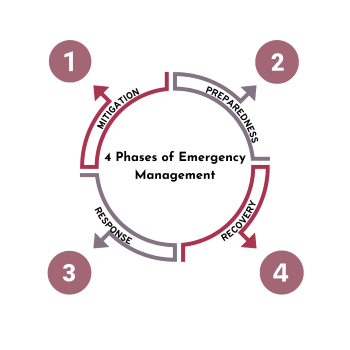The 4 Phases of Emergency Management
Mitigation, Preparedness, Response, and Recovery Are The Phases For Emergency Management
According to FEMA, Emergency Management is the managerial function and continuous cycle of planning. It is charged with creating the framework within which communities reduce vulnerability to hazards and cope with disasters. Its goal is to encourage safer and less vulnerable communities. They should be able to cope with disasters and hazards by coordinating and integrating all pursuits necessary to build, sustain, and improve communities’ ability to prevent, prepare for, respond to, and recuperate from natural or man-made disasters.
There are 4 phases of Emergency Management:
- Mitigation
- Preparedness
- Response
- Recovery

Mitigation
The focus of mitigation efforts is to take actions to avoid an incident before it can happen, reduce the chances of emergencies happening, and reduce the potential damaging effects in the case of an unavoidable emergency event. This includes deterrence operations and surveillance to prevent human hazards like terrorist attacks and natural disasters. Mitigation activities should begin long before an emergency.
An example of mitigation is buying flood insurance for your home or business.
Mitigation activities happen both before and after emergencies happen.
Preparedness
The preparedness phase centers on proactive activities that increase a community’s ability to respond to a disaster when it occurs, reducing its impact. It includes making plans and/or preparations made to help response and rescue operations and save lives. Preparedness is a continuous cycle.
An example of preparedness is stocking food and water and forming evacuation plans for different disaster case scenarios, or being sure that your home or business meets building codes.
Preparedness activities transpire before an emergency happens.
Response
Response actions include taking steps to prevent further property damage to the affected area and save lives to reduce economic loss, alleviate suffering, and save lives. The response phase means putting the the plans you made in the preparedness phase into action.
An example of response is taking shelter in a safe place you identified prior during a natural disaster such as a tornado.
Response activities are carried out during an emergency happens.
Recovery
The recovery phase includes actions taken after an emergency or disaster in order to return to a normal, near-normal, or an even safer situation following the emergency event. It includes the repair of socio-economic, social, and physical damages.
An example of recovery is finding financial assistance to pay for repairs, or deploying search and rescue teams and emergency healthcare providers to provide medical care.
Recovery activities occur after an emergency happens.
The Emergency Management Cycle is a continuous cycle of planning that is meant to be reworked and improved upon in every Incident Command System. It is important that all communities are in at least one phase of the emergency management system at all times. Ideally, a community will stay in and improve upon the mitigation and preparedness stages indefinitely, but working the Emergency Management phases means better chances of harm reduction during, and recovery after a natural or human-caused emergency takes place.
